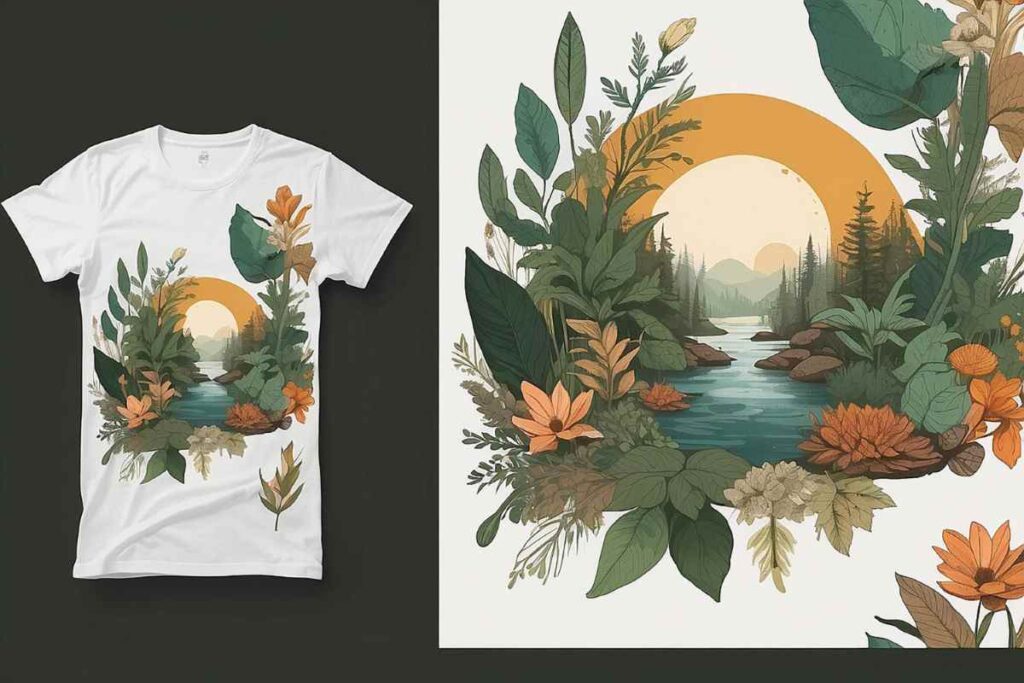DTF transfers, or Direct-to-Film transfers, have emerged as a game-changing technique in the world of custom garment decoration. This innovative method allows artists and businesses to print vivid, detailed designs directly onto a special film, which is then transferred to fabric with the help of heat and pressure. With DTF printing benefits such as full-color capabilities, durability, and quick turnaround times, it’s no wonder this approach is rapidly gaining traction among both hobbyists and professionals. In this ultimate DTF printing guide, we will uncover its unique features, practical applications, and the endless opportunities it presents for creative apparel printing. Whether you’re looking to start a business or personalize your wardrobe, DTF transfers offer a fresh and dynamic way to express your style.
Welcome to the fascinating world of film transfer printing, where creative possibilities are virtually limitless! Direct-to-Film technology, often referred to as DTF, is transforming the landscape of custom textile production. This contemporary method is praised for its versatility in producing stunning visuals on a variety of fabrics. By utilizing cutting-edge techniques in custom garment decoration, hobbyists and entrepreneurs alike are discovering an exciting avenue to showcase their designs. Join us as we explore this innovative printing option, its myriad advantages, and how it can elevate your apparel design projects to new heights.
Understanding the DTF Transfer Process
Direct-to-Film (DTF) transfers represent a revolutionary method in garment decoration, allowing for intricate and vibrant designs to be printed onto a special film that can readily adhere to various fabrics. The DTF printing process begins by creating high-resolution images which are then printed onto a specialized transfer film using eco-friendly inks. Once the print is completed, this film is coated with a heat-activated adhesive powder that binds the design to the fabric during the heat press application. This innovative technique diverges from traditional methods such as screen printing, as it eliminates the need for extensive setups and allows for more complex designs with minimal effort.
This process not only enhances the quality of the prints but also expands the range of fabric choices available to users. DTF transfers are compatible with natural fibers, synthetic fabrics, and blends alike, making them versatile for diverse applications. Whether creating custom t-shirts, hoodies, or promotional items, DTF printing ensures your designs come to life with brilliant colors and excellent detail. Furthermore, with proper care, DTF prints exhibit impressive durability and can withstand numerous washes without fading, making them ideal for custom garment decoration.
The Unique Benefits of DTF Printing
DTF printing offers a range of benefits that make it an appealing choice for both small businesses and hobbyists in the custom apparel space. One of the most significant advantages is the ability to produce high-quality graphics with vibrant color accuracy, rivaling that of traditional screen printing techniques. Unlike screen printing, which often requires significant setup time and cost for each design, DTF allows users to easily switch between designs with minimal downtime, making it perfect for short runs or one-off customizations.
Moreover, DTF transfers require no fabric pre-treatment, streamlining the printing process. Users can directly apply the DTF designs onto various fabric types such as cotton, polyester, and blends without additional steps, reducing both the time and labor involved in production. Additionally, the eco-friendly nature of the inks used in DTF printing aligns with current sustainability trends, making it an attractive option for environmentally conscious creators looking to minimize their ecological footprint in custom garment decoration.
Recent Trends in the DTF Printing Market
As the demand for personalized fashion continues to rise, the DTF printing market is experiencing significant growth. Market analyses indicate that more entrepreneurs and small businesses are investing in DTF technology to meet consumer needs for unique, custom items. This uptick in popularity is driven by the accessibility and versatility of DTF printing, enabling users to create bespoke products that stand out amid the saturated apparel market. With advancements in technology, the cost of DTF setups has also decreased, making it more feasible for new entrants to start small businesses centered around custom apparel.
Furthermore, as e-commerce takes a stronghold in retail, the convenience of DTF printing for filling niche markets is increasingly evident. Online businesses can leverage DTF technology to fulfill orders for custom designs quickly and efficiently, allowing for rapid turnarounds that are critical in today’s fast-paced environment. As the market continues to evolve, staying updated with the latest trends and techniques will be essential for those looking to capitalize on DTF’s growth potential.
Comparing DTF Printing to Other Techniques
In the landscape of custom garment decoration, DTF printing holds several advantages over traditional printing methods such as screen printing and heat transfer vinyl. One of the primary distinctions is the speed and efficiency with which DTF prints can be produced, facilitating a quicker turnaround time that benefits businesses focusing on fulfilling rapid customer demands. Unlike screen printing, which requires separate screens for each color in a design, DTF can manage full-color prints in a single run, significantly simplifying the overall process.
Moreover, DTF printing provides superior color vibrancy, allowing designs to maintain their sharpness and liveliness for longer periods, essential for branding and product appeal. This capability is accomplished without the necessity for pre-treating fabrics, further streamlining the setup process. As users transition from other printing approaches to DTF, they often find that the versatility and effectiveness of DTF not only enhance their production capabilities but also improve the quality of their final products.
Getting Started with DTF Printing: A Beginner’s Guide
Embarking on the journey of DTF printing may seem daunting for beginners; however, a wealth of resources is available to guide you through the initial stages. Understanding the essential components, such as selecting the right printer and choosing high-quality films and inks, is crucial for achieving stunning results. Setting up a space conducive to DTF printing, along with acquiring a reliable heat press, will set the foundation for successful projects. Beginners should also familiarize themselves with the various types of fabrics to find optimal compatibility for their intended designs.
Online forums, tutorials, and user guides are invaluable for novices in the DTF landscape, offering insights into troubleshooting common printing issues and maximizing the potential of their equipment. Experimenting with different materials and printing techniques is a great way to refine your skills while building a diverse portfolio of creative apparel printing projects that showcase your unique artistic flair.
Best Practices for Successful DTF Transfers
To ensure the success of your DTF printing projects, adhering to best practices is essential. Start with high-quality transfer films and inks, as the materials you choose directly impact the vibrancy and durability of your prints. Proper maintenance of your printer, including regular cleaning of the print head and optimal setup adjustments, will help prevent costly errors during the printing process. Additionally, tweaking your heat press settings—adjusting temperature and pressure—will yield better adhesion and finish across different fabric types.
Conducting test prints on a variety of fabrics is highly recommended, as this helps refine settings tailored to each material’s unique characteristics. Such experimentation can reveal important insights into how each fabric interacts with the DTF print, enabling you to better forecast outcomes for your finalized designs. As you become more familiar with the DTF process, these best practices will pave the way for consistently stunning results in your custom garment decoration endeavors.
Frequently Asked Questions
What are DTF Transfers and how do they work?
DTF transfers, or Direct-to-Film printing, involve printing designs onto a special film that is then adhered to fabric using heat and pressure. This technique allows for full-color prints on various materials, ensuring high-quality, durable designs ideal for custom garment decoration.
What are the benefits of using DTF printing for apparel?
DTF printing offers several benefits including superior color vibrancy, faster turnaround times, and the ability to print on various fabric types without the need for pre-treatment. Additionally, DTF transfers maintain their quality and vibrancy after multiple washes, making them perfect for custom apparel.
How does DTF printing compare to traditional printing methods?
DTF printing surpasses traditional methods like screen printing in terms of efficiency and quality. It enables quicker production times, offers better color accuracy, and reduces setup complexity by eliminating the need for fabric pre-treatment.
Are there any specific maintenance tips for DTF printers?
To enhance the longevity of your DTF printer, regularly clean the print head and maintain proper settings for temperature and pressure during transfers. This ensures optimal performance and superior print quality for your custom garment decoration projects.
Where can beginners find a DTF printing guide or resources?
Beginners can access numerous online resources such as tutorials on YouTube, blogs, and forums dedicated to DTF printing. These platforms offer comprehensive guides on setup, material selection, and troubleshooting techniques that can help new users navigate the DTF landscape.
What’s the best approach to achieve high-quality DTF transfers?
To achieve stunning results with DTF transfers, use high-quality films and inks, maintain your printing equipment, adjust heat press settings accurately, and conduct fabric tests. This practice will ensure vibrant prints and successful apparel decoration.
| Key Aspect | Details |
|---|---|
| Introduction | DTF transfers unleash creativity in textile printing, offering accessible and efficient garment decoration. |
| What are DTF Transfers? | A method that prints designs onto film and transfers them onto fabric using heat and pressure, allowing for full-color prints and high durability. |
| Market Growth and Popularity | The DTF transfer market is expanding due to increased demand for custom apparel, driven by e-commerce and personalized fashion. |
| Technical Advancements | Improvements in printing technology have made DTF more sustainable, accessible, and efficient for small businesses. |
| Comparison with Other Methods | DTF offers faster turnaround times, superior color vibrancy, and no need for fabric pre-treatment, making it preferable to other printing methods. |
| User Guides and Tutorials | Resources available for setup, material selection, and troubleshooting to help newcomers succeed in DTF printing. |
| Recommended Practices | Using high-quality materials, maintaining print heads, and testing on various fabrics are keys to achieving excellent results. |
Summary
DTF Transfers are transforming the landscape of custom apparel, enabling individuals and businesses to embrace their creativity like never before. This innovative printing technique ensures vibrant, durable designs that can be easily applied to a variety of fabric types. With the surge of e-commerce and the growing demand for personalized fashion, DTF Transfers stand out as an efficient and accessible solution for garment decoration. By following best practices and leveraging available resources, anyone interested in the world of textile printing can harness the full potential of DTF Transfers to create stunning and unique apparel.


